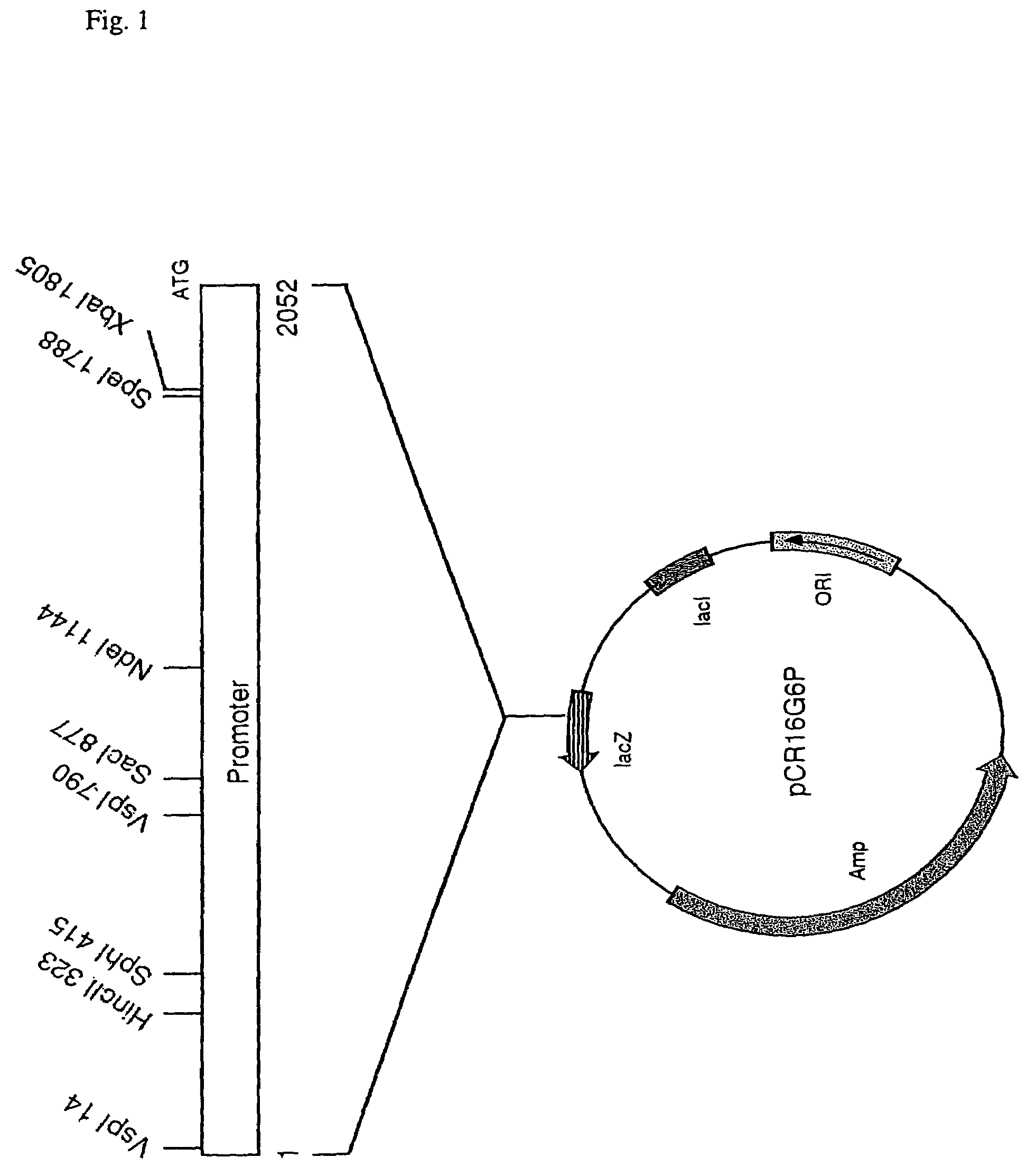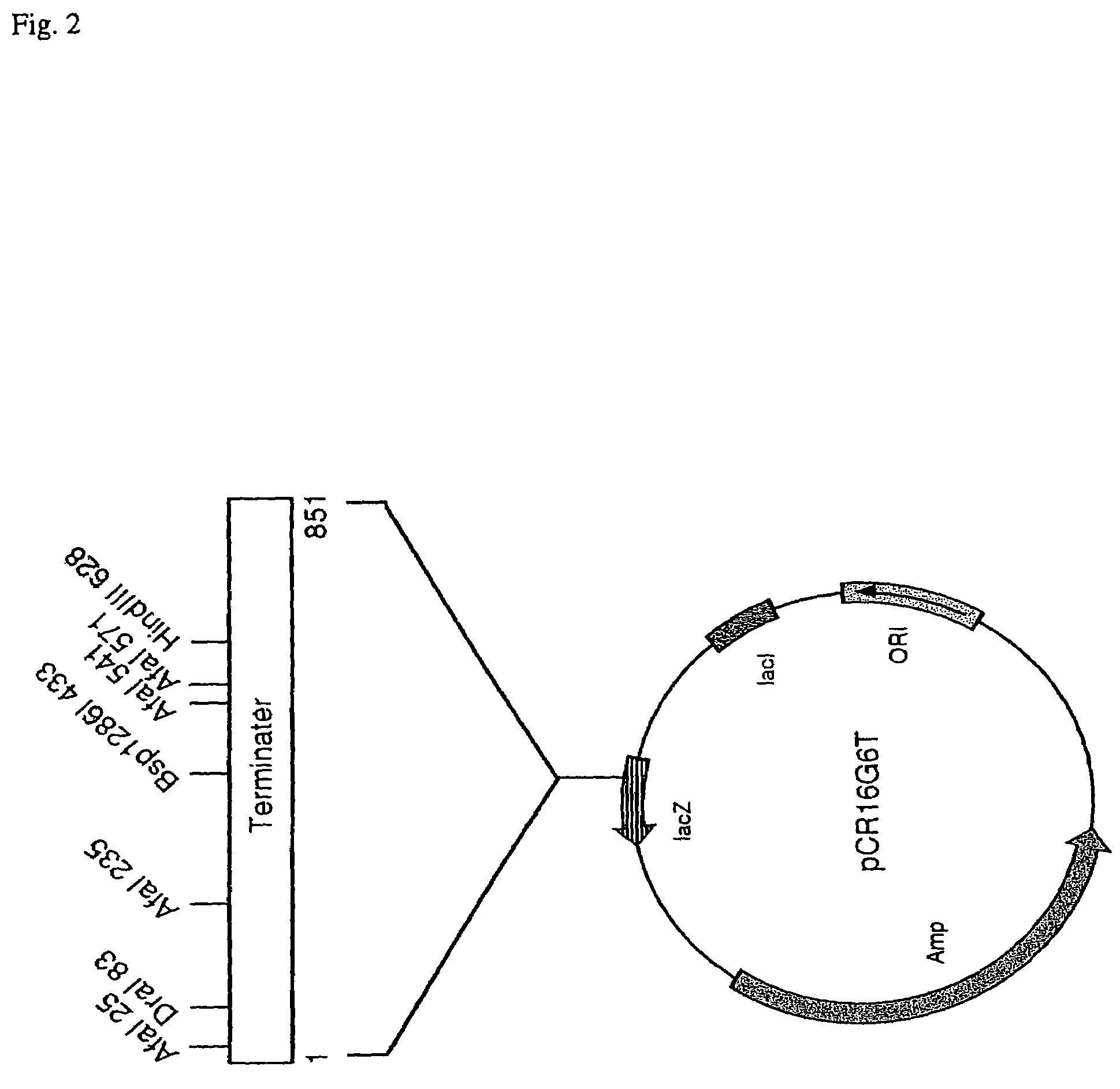Plant promoters and plant terminators
- Summary
- Abstract
- Description
- Claims
- Application Information
AI Technical Summary
Benefits of technology
Problems solved by technology
Method used
Image
Examples
example 1
Isolation of Promoter and Terminator of the Present Invention
[0073]A promoter of the present invention and a terminator of the present invention were obtained by conducting inverse polymerase chain reaction (inverse PCR) using genomic DNA prepared from carrot leaves. The procedures are described below.
(1) Preparation of Carrot Genomic DNA
[0074]Ten gram of carrot leaves at 6 week-old seeding was ground in liquid nitrogen, suspended in 5 ml of 2×CTAB solution (2% cetyltrimethylammonium bromide, 100 mM Tris-HCl buffer pH 8.0, 20 mM EDTA pH 8.0, 1.4 M sodium chloride, 1% polyvinylpyrrolidone), and then incubated at 55° C. for 10 minutes. To this, an equal volume of chloroform / isoamyl alcohol (24:1) was added, gently mixed for 30 minutes at room temperature, and then centrifuged to recover the upper and lower layers separately. (1) An equal volume of chloroform / isoamyl alcohol (24:1) was added to the upper layer, while (2) an equal volume of 1×CTAB solution (a solution obtained by two-fo...
example 2
Production of Transgenic Plant into which Promoter of the Present Invention has Been Introduced
(1) Construction of Ti Plasmid Expression Vector
[0085]Oligonucleotides G and H having the following nucleotide sequences that contain restriction enzyme-recognition nucleotide sequences for cloning: oligonucleotide G: 5′-GGAAG CTTCA TGTGT GCCCT ACAGC ACA-3′ (28 mer) oligonucleotide H: 5′-GGTCT AGAGA TCTTT AGAAT GTGAT TGCTG-3′ (30 mer), were synthesized and used as primers to conduct PCR (40 cycle of incubation at 94° C. for 1 min, then at 55° C. for 2 min, and further at 74° C. for 3 min per cycle) using, as a template, the plasmid having the nucleotide sequence shown in SEQ ID No: 1 that was obtained in Example 1. The amplified DNA fragment was treated with 10 U of Hind III and 10 U of Xba I to digest it completely, and part of the digest was then fractionated on 0.8% agarose gel. The DNA band of about 1.7 kb in size was excised, and DNA contained in the section was purified using glass b...
example 3
Confirmation of Transgene in Transgenic Plants
[0093]The transgenic tobacco seeds was immersed for 5 minutes in 2.5% sodium hypochlorite / 0.002% Triton X-100, followed by washing 4 to 5 times with sterile water, and then aseptically germinated by culturing on MS medium containing 100 μg / ml kanamycin. From a plant that exhibited kanamycin resistance, genomic DNA was prepared by the CTAB method. Using 50 ng of this DNA as a template, PCR (40 cycles of incubation at 94° C. for 1 min, then at 55° C. for 2 min, and further at 72° C. for 3 min per cycle) was conducted either using, as primers, a combination of oligonucleotide I comprising a part of the nucleotide sequence of GUS gene, which is a reporter gene, and oligonucleotide J comprising a part of the nucleotide sequence of the promoter of the present invention containing DNA which comprises the nucleotide sequence shown in SEQ ID No: 1 or SEQ ID No: 7:
oligonucleotide I: 5′-ATCAA CACCT CAACA TTGAT GTTAG CGTAC-3′ (30 mer)
oligonucleotide...
PUM
| Property | Measurement | Unit |
|---|---|---|
| Temperature | aaaaa | aaaaa |
| Fraction | aaaaa | aaaaa |
| Fraction | aaaaa | aaaaa |
Abstract
Description
Claims
Application Information
 Login to View More
Login to View More - R&D Engineer
- R&D Manager
- IP Professional
- Industry Leading Data Capabilities
- Powerful AI technology
- Patent DNA Extraction
Browse by: Latest US Patents, China's latest patents, Technical Efficacy Thesaurus, Application Domain, Technology Topic, Popular Technical Reports.
© 2024 PatSnap. All rights reserved.Legal|Privacy policy|Modern Slavery Act Transparency Statement|Sitemap|About US| Contact US: help@patsnap.com










